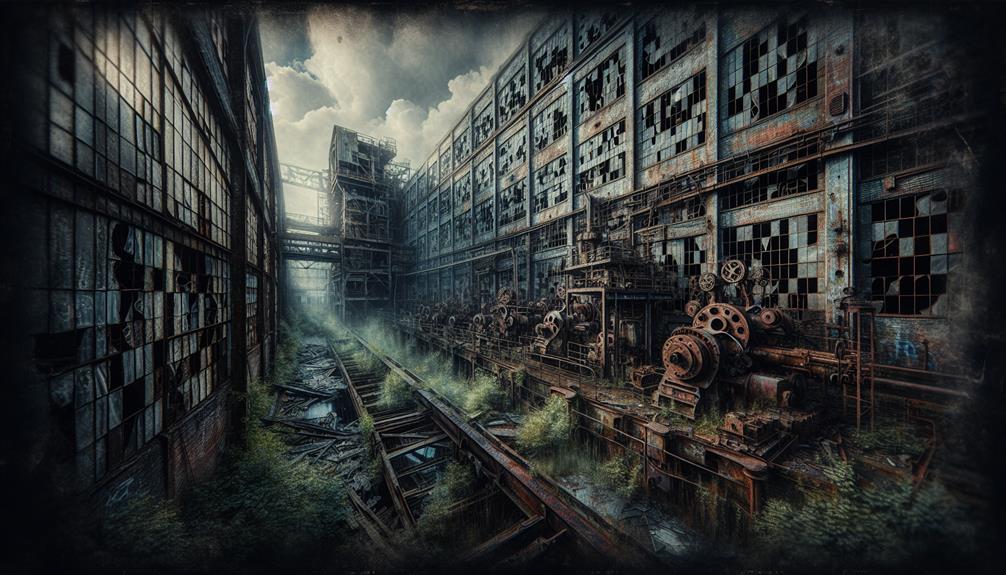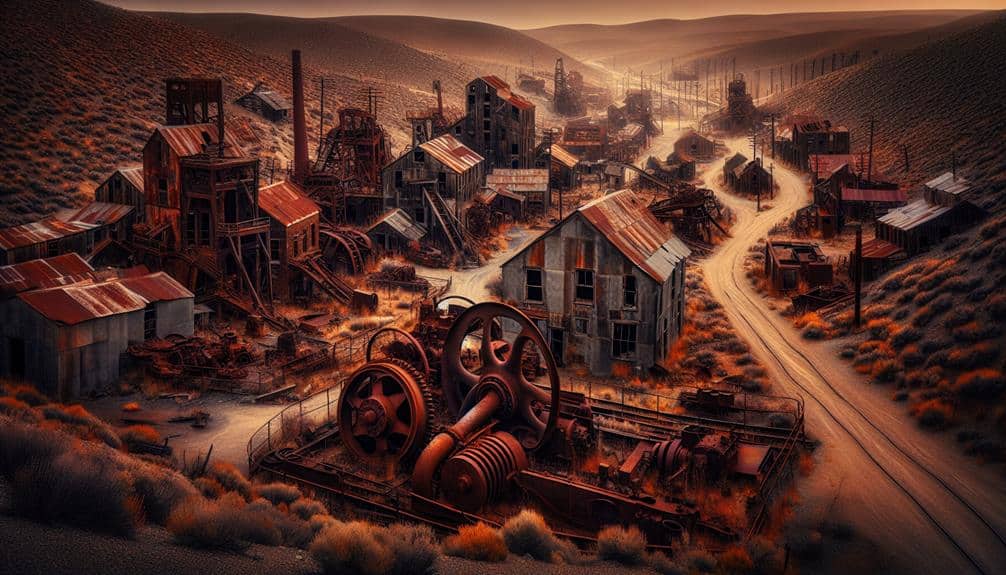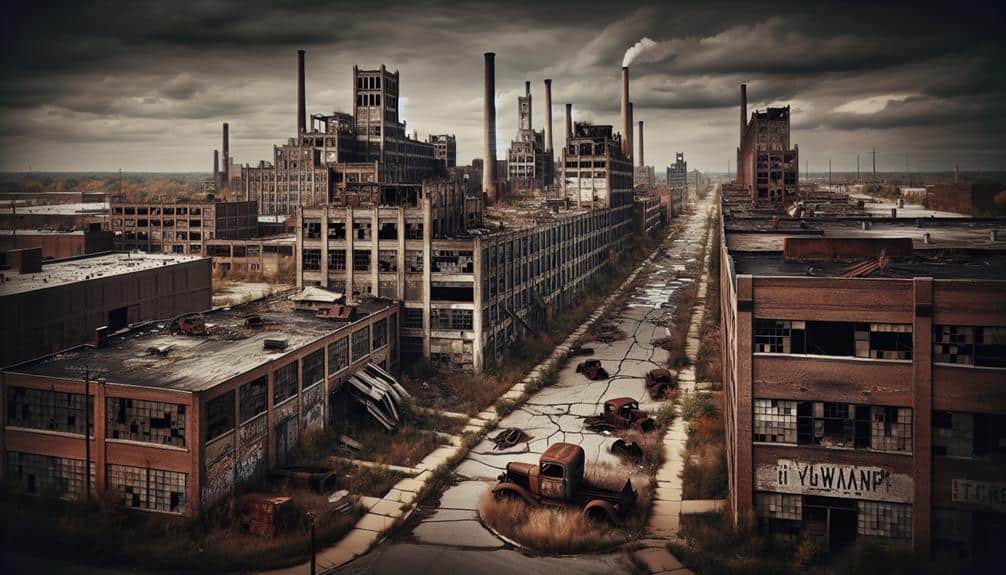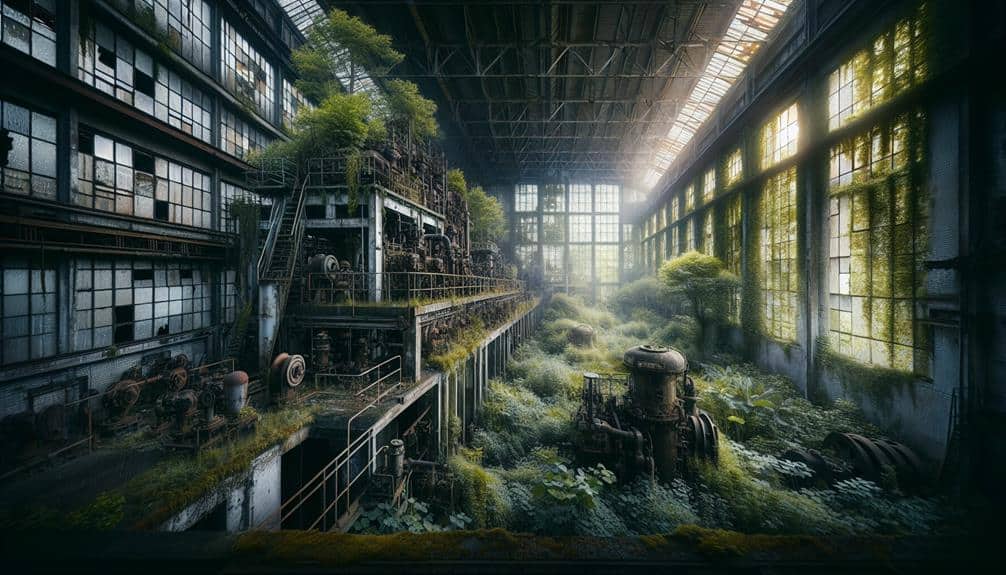Explore eerie remnants of once-thriving industrial hubs in the Rust Belt, where economic shifts left hauntingly abandoned cities. Detroit, Michigan, saw population drop from 1.9 million to 670,000. Gary, Indiana, faced rapid decline with the steel industry's fall, grappling with crime and vast abandoned properties. These cities symbolize economic challenges of industrial centers. Learn more about the history, factors, and preservation efforts to revitalize these forgotten centers.
Key Points
- Detroit, Michigan, faced drastic population decline from 1.9 million to 670,000.
- Gary, Indiana, saw rapid population decline due to the fall of the steel industry.
- Abandoned buildings in Detroit and vast properties in Gary symbolize economic challenges.
- Urban decay in Rust Belt cities resulted from industrial decline and job losses.
- Economic impact of ghost towns includes infrastructure decay and shrinking tax base.
History of Rust Belt Abandoned Cities
In the Rust Belt, numerous cities were once thriving industrial centers but have since become abandoned due to economic shifts and population decline. The industrial decline in these cities, characterized by the collapse of manufacturing industries, led to widespread job losses and economic hardship. As factories closed down and moved operations elsewhere, residents faced unemployment and poverty, prompting many to leave in search of better opportunities.
Urban decay became a common sight in these abandoned cities, with vacant buildings, deteriorating infrastructure, and declining property values. The once bustling streets now lay quiet, overtaken by overgrown vegetation and graffiti-covered walls. The lack of investment and resources further exacerbated the decay, creating a cycle of decline that seemed difficult to break.
The legacy of industrial decline and urban decay serves as a reminder of the challenges faced by communities in the Rust Belt. Understanding the history of these abandoned cities sheds light on the complex factors that contributed to their current state of abandonment.
Factors Contributing to Abandonment
The economic shifts and population decline in the Rust Belt abandoned cities were primarily driven by a significant downturn in manufacturing industries. This resulted in widespread job losses and urban decay. As manufacturing plants closed or moved overseas seeking cheaper labor, many residents lost their jobs, leading to a mass exodus from these once-thriving urban areas.
The decline in job opportunities not only caused population decline but also triggered a domino effect, impacting local businesses, schools, and infrastructure. With fewer residents contributing to the local economy, the tax base eroded, making it challenging for city governments to maintain essential services and invest in community development projects.
This cycle of urban decay further deterred potential investors and residents, perpetuating the abandonment of these Rust Belt cities. The resulting vacant buildings and neglected neighborhoods stand as stark reminders of the economic challenges and population shifts that have shaped the landscape of the Rust Belt.
Notable Abandoned Cities in Rust Belt
Prominent among the abandoned cities dotting the Rust Belt are remnants of once-thriving industrial hubs left desolate by economic upheavals. Urban decay and population decline have ravaged cities like Detroit, Michigan, once a powerhouse of the automobile industry. Detroit's population plummeted from a peak of nearly 1.9 million in the 1950s to around 670,000 today. The city's abandoned buildings and factories stand as haunting reminders of its former glory, now overrun by nature and neglect.
Another notable abandoned city is Gary, Indiana, which was once a bustling steel town. As the steel industry declined, Gary faced a rapid population decline, with many residents leaving in search of better opportunities. Today, the city grapples with high crime rates and vast swaths of abandoned homes and businesses.
These abandoned cities in the Rust Belt serve as poignant symbols of the economic challenges and hardships faced by once-thriving industrial centers.
Economic Impact of Ghost Towns
Amidst the desolate remnants of once-thriving industrial hubs in the Rust Belt lie ghost towns whose economic impact reverberates through the region. Urban decay and population loss are common characteristics of these deserted areas. The economic decline in these ghost towns has led to a domino effect, triggering infrastructure decay and abandonment of commercial and residential properties.
The economic impact of ghost towns goes beyond the surface level. Businesses that once thrived in these areas have closed down, leading to job losses and a shrinking tax base for local governments. This, in turn, has resulted in a lack of funds for maintaining infrastructure, further exacerbating the problem of decay and neglect.
The ripple effects of these economic downturns are felt throughout the region, with neighboring towns also experiencing challenges due to the spillover effects of ghost towns. Addressing the economic impact of these abandoned areas is vital for revitalizing the Rust Belt and fostering economic growth in the region.
Preservation Efforts and Future Prospects
Efforts to preserve the abandoned cities in the Rust Belt and explore future prospects are essential for revitalizing the region's economic landscape. Community engagement plays an important role in these preservation endeavors, fostering a sense of ownership among residents and stakeholders. Urban revitalization initiatives aim to breathe new life into these forgotten urban centers, creating opportunities for economic growth and cultural resurgence. By involving the community in restoration projects, a shared vision for the future of these cities can be cultivated, ensuring sustainable development and long-term success.
Looking ahead, the future prospects of these abandoned cities hinge on the collaborative efforts of local governments, businesses, and residents. Through strategic planning and investment, these cities can transform into vibrant hubs of activity once again. Embracing innovation and creativity in urban design can attract new businesses, residents, and tourists, driving economic prosperity and social cohesion. By preserving the historical essence of these cities while adapting to modern needs, the Rust Belt can write a new chapter in its storied history, redefining itself as a beacon of urban renewal and community resilience.
Frequently Asked Questions
What Are Some Common Myths or Misconceptions About Abandoned Cities in the Rust Belt?
Misunderstandings about abandoned cities in the Rust Belt frequently disregard the intricacies of urban decay. Environmental impact is substantial, influencing wildlife preservation. It is crucial to grasp the genuine challenges beyond superficial assumptions for efficient solutions.
How Do Abandoned Cities in the Rust Belt Impact the Environment and Wildlife in the Surrounding Areas?
When abandoned cities linger in the Rust Belt, habitat loss disrupts ecosystems, impacting biodiversity. Restoring these areas is crucial for wildlife conservation. The relationship between urban decay and natural world is a delicate balance.
Are There Any Unique or Unusual Abandoned Structures or Landmarks in Rust Belt Ghost Towns?
Explore the Rust Belt's ghost towns for haunting architecture and forgotten landmarks. Uncover hidden treasures amidst urban decay. Witness the stories etched in abandoned structures, a glimpse into a bygone era waiting to be discovered.
How Do Abandoned Cities in the Rust Belt Affect Neighboring Communities and Their Residents?
When abandoned cities in the Rust Belt crumble, economy falters, social fabric frays. Neighboring communities bear the brunt, feeling the ripple effects of decay. You witness firsthand the toll on livelihoods, relationships, and hope.
What Role Do Abandoned Cities in the Rust Belt Play in Local Folklore or Urban Legends?
Explore local legends surrounding abandoned cities in the Rust Belt. Ghost stories, folklore, and urban myths intertwine with mysterious disappearances, crafting eerie tales that linger. Uncover the haunted tales that shroud these forsaken places.



